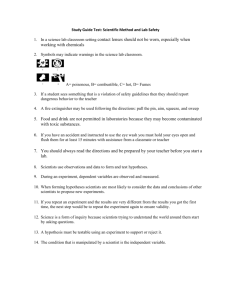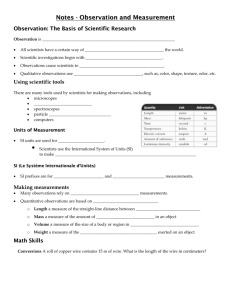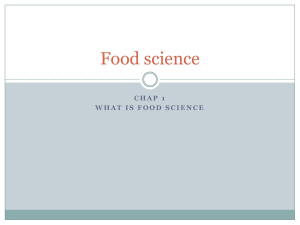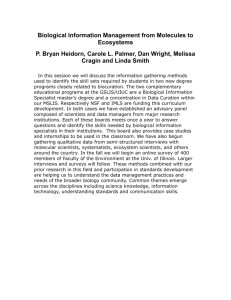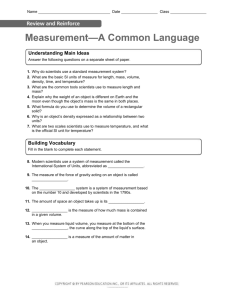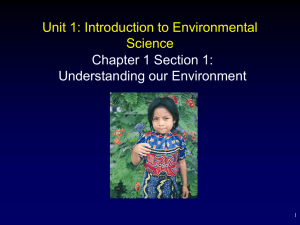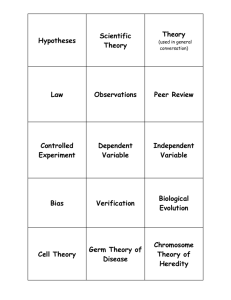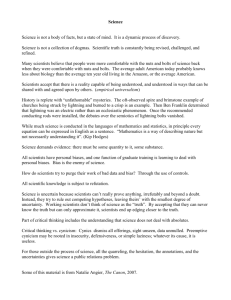Science Versus the Public: Water Matters 69 KB
advertisement
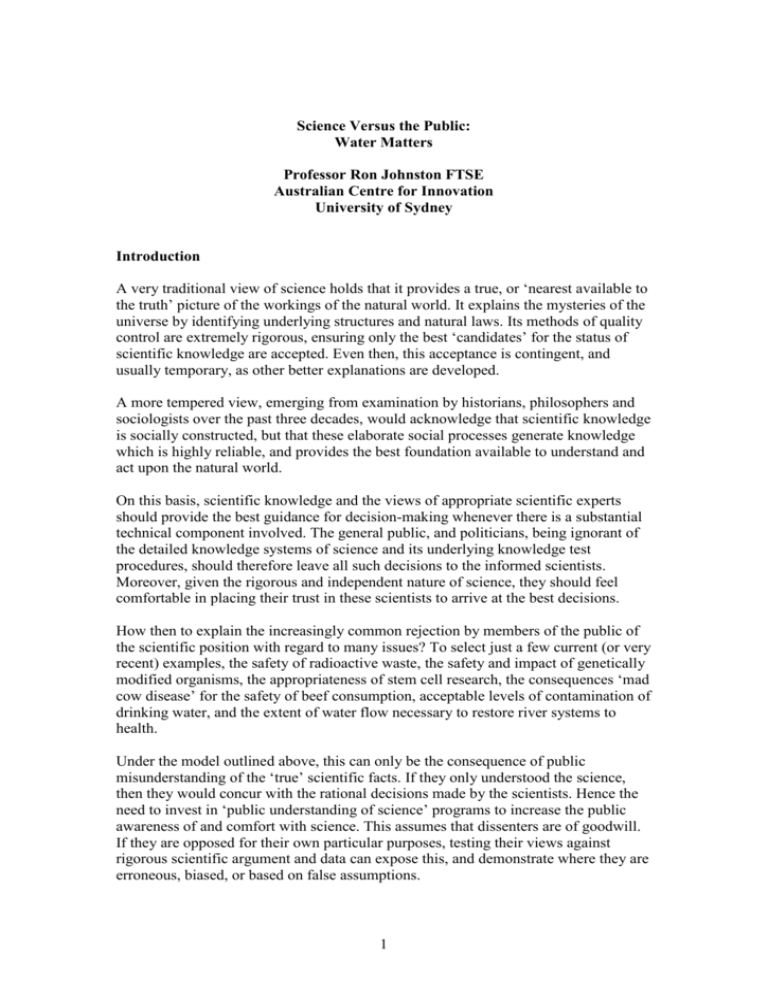
Science Versus the Public: Water Matters Professor Ron Johnston FTSE Australian Centre for Innovation University of Sydney Introduction A very traditional view of science holds that it provides a true, or ‘nearest available to the truth’ picture of the workings of the natural world. It explains the mysteries of the universe by identifying underlying structures and natural laws. Its methods of quality control are extremely rigorous, ensuring only the best ‘candidates’ for the status of scientific knowledge are accepted. Even then, this acceptance is contingent, and usually temporary, as other better explanations are developed. A more tempered view, emerging from examination by historians, philosophers and sociologists over the past three decades, would acknowledge that scientific knowledge is socially constructed, but that these elaborate social processes generate knowledge which is highly reliable, and provides the best foundation available to understand and act upon the natural world. On this basis, scientific knowledge and the views of appropriate scientific experts should provide the best guidance for decision-making whenever there is a substantial technical component involved. The general public, and politicians, being ignorant of the detailed knowledge systems of science and its underlying knowledge test procedures, should therefore leave all such decisions to the informed scientists. Moreover, given the rigorous and independent nature of science, they should feel comfortable in placing their trust in these scientists to arrive at the best decisions. How then to explain the increasingly common rejection by members of the public of the scientific position with regard to many issues? To select just a few current (or very recent) examples, the safety of radioactive waste, the safety and impact of genetically modified organisms, the appropriateness of stem cell research, the consequences ‘mad cow disease’ for the safety of beef consumption, acceptable levels of contamination of drinking water, and the extent of water flow necessary to restore river systems to health. Under the model outlined above, this can only be the consequence of public misunderstanding of the ‘true’ scientific facts. If they only understood the science, then they would concur with the rational decisions made by the scientists. Hence the need to invest in ‘public understanding of science’ programs to increase the public awareness of and comfort with science. This assumes that dissenters are of goodwill. If they are opposed for their own particular purposes, testing their views against rigorous scientific argument and data can expose this, and demonstrate where they are erroneous, biased, or based on false assumptions. 1 However assumptions about the reliability of scientific knowledge, particularly in addressing the increasing array of rapidly emerging, complex issues, the translation of this knowledge into decisions, the assumed ignorance of non-experts, and the basis for trust in such processes have been thrown into considerable question by a range of both theoretical developments and practical experience.1 These will be explored in the next section, followed by a number of case studies of disputes between scientists and stakeholders over decisions about water resources. The Challenge to Scientific Authority The Reliability of Scientific Knowledge The widespread recognition of the many successes of science which have created a demand for greater investment and returns, has, somewhat paradoxically it has been argued, lead to the displacement of the traditional model of knowledge generation and application, at least in part, by a new model.2 (Gibbons et al, 1994) In this model: problems are substantially set and solved in the context of application, rather than in that of the relevant research/academic community; instead of problems, research agendas and accepted solutions being determined within a disciplinary framework, they are based on and judged against trans-disciplinary approaches and resources; rather than a homogeneous community of discourse, heterogeneous skills and experience direct the knowledge production; the organisational form is weakly institutionalised, transient and heterarchical, in contrast with the relatively permanent, hierarchical character of universities and research institutions in the past; and quality control, instead of being based only on internal peer review, increasingly involves wider criteria based on efficacy of application, reflecting the wider social composition of the interested audience.3 It is apparent that these changes clearly mark a shift away from a relatively isolated community and practice of science, to a situation where they are far more embedded in the interests of wider elements of the community, and are judged in part on the way and extent to which they meet these needs. As a consequence: The once clear lines of demarcation between government, industry and the universities, between science of the universities and the technology of industry, between basic research, applied research and product development, There is a general movement in both Europe and the US, aimed at “democratising expertise” ie reducing its privileged elite status, while at the same time developing mechanisms to more effectively interface between expertise and government “expertising democracy” (Liberatore and Funtowicz, 2003). However, this chapter addresses the more specific interplay between scientists and stakeholders over sspecific decisions. 2 The inelegant labels of Mode 1 and Mode 2 will not be used in this paper. 3 Paraphrased from Johnston, 1998. 1 2 between careers in academe and those in industry seem no longer to apply. Instead, there is movement across established categories, greater permeability of institutional boundaries, greater blurring of professional identities…science has been invading, but also invaded by countless demands of society. (Gibbons, 2003, p.53) Under these circumstances, the presumed separation between scientific experts and the general public, and even more so with regard to stakeholders with a legitimate interest, can be expected to have declined. Scientists have been involved in shaping, or pronouncing on, decisions of direct interest to the stakeholders, and the stakeholders have a keener interest in the framing of these decisions, and the adequacy of the information on which they are based. A far more comprehensive model of this changed relationship, and its implications, proposes that not only have the conditions of production changed, but science itself has developed a new form: Whereas science was previously understood as steadily advancing in the certainty of our knowledge and control of the natural world, now science is seen as coping with many uncertainties in policy issues of risk and the environment. In response, new styles of scientific activity are being developed… The science appropriate to this new condition will be based on the assumptions of unpredictability, incomplete control, and a plurality of legitimate perspectives… The emerging science fosters a new methodology [in which] uncertainty is not banished but is managed, and values are not presupposed but are made explicit. The model for scientific argument is not a formalized deduction but an interactive dialogue. (Funtowicz, and Ravetz, 1993, p.739-40) These new policy issues have common features that distinguish them from traditional scientific problems: They are universal in their scale and long-term in their impact. Data on their effects, and even data from baselines of ‘undisturbed’ systems are radically inadequate. The phenomena, being novel, complex, and variable, are themselves not well understood. Science cannot provide well founded theories …but only mathematical models and computer simulations, which are essentially untestable. On the basis of such uncertain inputs, decisions must be made, under conditions of some urgency. Therefore policy cannot proceed on the basis of factual predictions, but only on policy forecasts.(Ibid, p.742) Four distinct types of science are identified, against the axes of knowledge, or more specifically systematic uncertainties of knowledge, and values, as reflected in ‘decision stakes’ – the costs, benefits and value commitments involved through the various stakeholders: i. core science – very low system uncertainties and decision stakes - Kuhn’s normal science in which epistemological uncertainty is low and application is incremental; 3 ii. iii. iv. applied science –low system uncertainties and decision stakes - missionoriented, where there is a prescribed outcome which strongly shapes the knowledge generation; there may be multiple routes to the goal which will be assessed against multiple application criteria; ‘professional consultancy’ – moderate system uncertainties and decision stakes - client serving, commonly with ill-defined objectives, frequently involved with adapting generic knowledge and data to specific local conditions; not clearly reproducible, hence allowing for legitimate resort to ‘second opinions’; post-normal science - high system uncertainties and decision stakes – issue driven, uncertainties deeply epistemological and/or ethical, decision stakes reflect conflicting purposes among stakeholders; in these circumstances, knowledge is so limited, uncertainty so great, and interests of stakeholders so strong, that the approach to generating useful knowledge must fully involve stakeholders and build from their perspectives and local knowledge. An example of post-normal science is provided by the current concerns and conflicts about global climate change and possible consequent sea-level rises. Knowledge is highly uncertain, possible implications are huge, lead-times to effective action are long (long before knowledge uncertainties can be substantially reduced), stakeholders are many, and policy options are all very costly. In addition, the approaches of, at one extreme ‘she’ll be right’, or at the other full application of the precautionary principle, do not offer an effective basis for dynamically engaging in the knowledge development and uncertainty reduction necessary for better decision-making. Returning to the four categories of science: the first category is thoroughly familiar. Categories 2 and 3 are largely familiar, and have reasonably well-developed procedures and quality control. But Category 4 is relatively new and our experiences are mainly of massive conflict, misunderstanding, dysfunctionality, and poor decision-making. This is where we need new capacity for engaging scientist with stakeholder, knowledge with action, and systematic knowledge with local knowledge. Translation of Scientific Knowledge into Decisions It has been demonstrated by many analyses over the past 25 years that application of general scientific knowledge to applications requires interpretation and local knowledge. The long history and contribution of the engineering disciplines, dedicated to the application of knowledge to achieve particular practical outcomes are in themselves abundant evidence. Studies of particular interpretations, or ‘translations’ involved with major risk assessment exercises (eg fluoride in drinking water, lead in petrol, animal and health effects of pesticides, human health effects of smoking, etc) have confirmed the extent of extra-scientific translation involved in bringing knowledge to bear on decisionmaking. In particular, in the domain of law, standards of evidence and proof and causality of connection, may be very different from that accepted I the world of science. In simple terms, there is no simple heuristic for the translation of scientific knowledge into decisions and policies. The realms of interpretation are so large, and the inability 4 of general knowledge to precisely pre-determine specific outcomes so great, that the translation process and domain is almost always open to different interpretation, and challenge. The Presumed Ignorance of non-Experts The traditional model outlined in the first section relies on a clear contrast between the specialist knowledge and understanding held by scientists, and the lack of that knowledge in the public. This perspective is challenged firstly by the increasing engagement by stakeholders of their own specialist scientific resources. But more fundamentally, the scientist often lacks the local knowledge held by stakeholders which provides a reasonable basis for very different interpretation of data and theory. This situation is demonstrated with remarkable clarity and detail in Wynne’s (1996) analysis of the interaction between Cumbrian hill sheep-farmers of the Lake district of Northern England with government scientists over the radioactive fallout from the 1986 Chernobyl nuclear reactor disaster in the Soviet Union.4 In short, what this analysis shows only too clearly, allowing that much of it can be accounted for in the customary terms of interplay between government bureaucrat and citizen, is that the officials called on the authority of science to make large claims which quite evidently proved to be false, and that the detailed local knowledge of the farmers was systematically ignored or under-valued. Furthermore, Wynne makes the case that there is rarely a single ‘one-size fits all’ public. There are many publics, with many different, and at times, opposing perspectives. Hence the equation is not between science and the public, but many sciences, and many publics. The Basis of Trust in Science-Community Relations There have been calls at regular intervals for a re-negotiation of the social contract between science and society and the relations of trust that both sides will adhere to the agreement. In the post- world War II era, this was formulated in terms of the provision of economically and socially valuable knowledge, and well-educated graduates, in return for a substantial level of public funding, and minimal interference in its use. But in the conditions outlined above, this separation is neither appropriate, nor does it, in practice, exist. Social demands enter the determination of what is an important problem to be addressed, what methods are available to examine it, who should be involved in each of these stages, and what processes should be used to insert the resultant knowledge into considerations. Gibbons (2003) argues that what is required is no longer merely reliable knowledge, but socially robust knowledge – knowledge whose validity is based on being tested in a range of contexts. 4 Precise details are not relevant here, but the reader is urged to access this account as a fascinating and exemplary account of the interplay between officialdom and farmers, and between scientists and locally well-informed citizens. 5 Irwin and Wynne (1996, p.7) stress the need to move towards a relational focus: that interprets both ‘science’ and the ‘general public’ as diverse, shifting and often diverging categories. Wynne (1999) further develops these ideas in an exploration of the basis of trust between the public and experts, pointing out that in most situations the public have such limited access to information, let alone power, that they have little alternative but to express a provisional trust, and hope that things will work out alright. He extends this into a consideration of an issue gaining attention in a number of quarters – the extent and ways in which the boundary between expert knowledge and lay knowledge can be made more permeable, and lay knowledge and expertise be brought to engage more effectively with scientific expertise. The four issues of the adequacy of traditional scientific knowledge to address many contemporary challenges, the translation of expert knowledge into effective, agreed decision-making, acknowledging and making effective use of lay knowledge, and establishing a basis of understanding of the value, roles and limitations of each type of knowledge within trust-based relationships, are being played out in a range of current problems. We will now seek to examine these issues in the Australian context of water resources. Water Matters The water resources upon which human life depends are under increasing stress. Almost no country will be spared the threat. Over the next 30 years, more than 60% of the world’s population will face severe water-related problems; ie 4-7 billion people. (Annan, 1997) Current patterns of water use are often not sustainable. There is mounting evidence that the world faces a worsening series of local and regional water quality and quantity problems, largely as a result of poor resource management, including ill-adapted allocative mechanisms, wasteful use of the resource, unregulated effluent disposal, and weak institutional frameworks. (UN Economic and Social Council) It has become widely accepted that there is a need for a new paradigm in water supply and management. The approach developed largely in the nineteenth century in Europe and the US, and followed in Australia, does not appear adequate to address the huge challenges that are emerging. While there is substantial room, and need for, incremental improvements, they alone will not be sufficient. Rather, approaches need to be based on the recognition of water as a precious and valuable resource, which needs to be used to maximum economic and social advantage. This requires the adoption and acceptance of demand, and integrated water resource, management. Expert-Lay Disputes over Water Issues Cullen (2003) provides a snapshot based on extensive personal experiences of disputes over water issues: 6 I want to talk about the particular challenges that I have faced in the water area, in trying to take science to what is a pretty sceptical, and diffuse, community. The decisions we make with our water generally involves millions of dollars to some beneficiaries who get access to a public resource… In many cases the science underpinning the water decisions is highly contested, and contested with a passion, with resources and with commitment that you wouldn’t believe.(p.2) In the development of a knowledge strategy for the Lake Eyre Basin, recognising the need to engage the community and provide the opportunity for input of local knowledge, a process was adopted which involved: establishment of a scientific advisory panel; selection of members to ensure not only with knowledge of Lake Eyre, but from different disciplinary perspectives; identification of a range of stakeholders; preparation of a series of short, plain English, theme papers, distributed to the community for comment and input; focusing their research on a limited number of aspects that can be influenced to make a significant difference. While the process is still in train and the value of the advice offered is yet to be tested, it has produced the basis for a far more effective dialogue between scientists and lay stakeholders with strong personal and financial interests, and considerable local knowledge. A second case involved a review of the science underpinning water allocations in the Lower Balonne south of St George, commissioned by the Queensland Premier, to support a proposal to resume a large cotton irrigation farm. Key features of the review and its context were: a climate of strong, vocal and well-organised opposition by the irrigators to the Premier’s plans, and distrust of any proposal offered by the Government; the scientific basis for the water management decisions was provided by a Queensland Government Department – the Department of Natural Resources; the commissioning by the irrigators of their own scientists, who challenged the Government position on a number of grounds; these included the health of the river channels, where the official information was based on sampling after a major flood, which may have provided an unrepresentative picture; another dispute was over the accuracy of water flow gauging and the modelling of water flows; as the objective announced had been to raise mean average flow from 47% to 53%, demonstratio of inaccuracies in measurement cast doubt on the basis for the target; invitations for submissions from the general public and the scientific community; the establishment of a community reference group to oversee the review, composed of 15 community representatives with highly disparate views; public workshops; a strategy on the part of opponents to highlight uncertainties in the science, of which there are many, and on this basis no decisions should be made until all the uncertainties are resolved; 7 evident difficulties in ‘translating’ the science into a sound basis for decisionmaking, particularly via politicians; strong media interest which sought to enhance adversarial stances. This case study might be considered a classic of science-lay disputes. A hostile climate is established by a government decision which impacts heavily on some interests, which is fanned by the media and well-organised opponents. The process is almost entirely political. The science in this case is the vehicle for pursuit of political ends. The claim is made that the scientific information, produced by the Government themselves, is flawed, inaccurate and possibly biased. In the face of so much uncertainty (in the context of the view that the role of science is to remove uncertainty), no decisions should be made until there is a sounder basis for it. Little wonder that a model of rational decision-making does not apply. A third case study, in which Cullen has been an active player, is associated with the ‘Wentworth Group’, in the context of the future health and viability of the MurrayDarling Basin, and more broadly managing the impact of drought on Australia. The Wentworth Group describe themselves as a “group [eleven] of Australia’s leading environmental scientists who are advocating radical and fundamental reform to halt further degradation of Australia’s landscapes”. (Wentworth Group, 2002) The Blueprint advocates five key actions: clarify water property rights and obligations restore environmental flows to stressed rivers end broadscale clearing of remnant native vegetation pay farmers for environmental services beyond a reasonable duty of care incorporate into the cost of food, fibre and water the hidden subsidies currently borne by the environment. Each of these five points has successfully become part of political and public debate in its own right. Many are involved in considerable controversy. However it is the second issue that has produced a controversy between these scientists and certain stakeholders, mainly those representing irrigation issues. In a follow-up report focussing just on water (Wentworth Group, 2003), they argued: There is an emerging view in the scientific community that if we remove more than two thirds of the natural flow [of rivers] we will cause obvious and significant damage to river health. Flow regimes of less than half-natural will mean that it is highly unlikely that a river will be capable of remaining healthy in the long-term. (p.7) As a consequence, they argue that the environmental needs of Australia’s rivers should have a guaranteed first priority call on water required to keep them healthy. In the particular context of the River Murray, this translates into “at least an additional 100 gigalitres (GL) per year. Indeed: The best available science suggests that achieving a healthy River Murray System will require between 2000GL and 4000GL of new environmental 8 flows, and profound changes in river management, to have a moderate-to-high chance of achieving success. (p.9) This view has been met with considerable opposition from irrigation groups, on a number of grounds5: the emphasis on increased flows would divert attention from important nonflow issues; an apparent strong bias of some members of the scientific community against irrigation; significant biases in the science underlying the arguments; unfounded claims that non-flow initiatives could not be traded off against flow initiatives; little attempt to quantify improvements which can be made through initiatives which are not related to flow; absence of new research; need for “real data, not just based on best guesses and opinions; need for more research into new agricultural and industry opportunities; salt interception schemes and future engineering works should take preference over increased flows. MIL has lobbied to ensure the scientific report being prepared for the Murray Darling Basin Commission’s Living Murray initiative is released to stakeholders, in order to allow their own scientists to examine the basis of the arguments. As in the previous game, it can be seen that the science cannot be separated from the political processes involved. Moreover, the ‘arms-length pronouncements of official scientists evidently carry only limited authority. The model of active engagement of the community and their lay knowledge recommended in the theoretical arguments above, and practised in the first case study, would appear to offer the prospect of more satisfactory outcomes. However, where interests are threatened, and the possibility of bringing influence to bear available, it would be naïve to suggest that even these processes would change the fundamental struggle for power. Conclusions The model of science as an independent, authoritative and arms-length contributor to, and determinant of, public decision-making is no longer valid. The limited capacity of traditional scientific knowledge to address many contemporary challenges, the importance of local lay knowledge, and the problems of translating scientific knowledge into decision-making, all have reduced the authority that science commanded in a previous age. Science can no longer be considered as above or beyond politics. As the case studies above show, science is being used as a tool in the political process in a number of distinct ways: challenging of the accuracy of the science claimed to support a position, alleging bias because of the affiliations or values of the 5 Drawn from press releases of Murray Irrigation Ltd: http://www.murrayirrigation.com.au accessed 5 November 2003. 9 scientists involved, drawing on another field of science to support alternative possibilities, and in a paradoxical appeal to the authority of science, arguing for no action until scientific uncertainties are resolved. Issues of water supply, access, management and quality engage so many legitimately (and sometimes illegitimately) interested parties, and carries such deep connotations and value associations, that political processes are likely to always dominate decision-making. Only political processes, designed to address irreconcilably opposed positions, are likely to be effective. Finally, lessons may be learnt from developments in public participation and engagement overseas. In the Scandinavian countries, and the Netherlands, the mechanism of a ‘consensus conference’ is in regular use to allow public input. These rely not on engaging stakeholders, but a random selection of citizens (akin to jury duty) in becoming informed about a topic, listening to and questioning experts, and preparing a consensus report of their opinions. The European Commission, as part of a Directive to establish a framework for Community action in water policy released in 2000, have mandated the adoption of processes that provide for information supply, consultation and active involvement. Models of procedures appropriate to stakeholders and the community are offered. (EC, 2002) 10 References Annan, Kofi, First World Water Forum, Marrakesh, Morocco, 1997, quoted in Johnston, R., Water Supply and Management, APEC Center for Technology Foresight, Bangkok, 1999. Cullen, P., ‘Address to the Conference Dinner’, ATSE Focus, No. 128, July/August 2003, pp.2-7. European Commission, Guidance on Public Participation in Relation to the Water Framework Directive, http://forum.europa.eu.int/Public/irc/env/wfd/library?l=/framework_directive, accessed 10 September 2003. Funtowicz, S., and Ravetz, J., ‘Science for the Post-Normal Age’, Futures, September 1993, pp 739-755. Gibbons, M., Limoges, C., Nowotny, H., Schwartzman, S., Scott, P., and Trow, M., The New Production of Knowledge, Sage, 1994. Gibbons, M., ‘Engagement as a Core value in a Mode 2 Society’, Chapter 3 in Bjarnson, S., and Coldstream, P., (eds), The Idea of Engagement: Universities in Society, Association of Commonwealth Universities, London, 2003. Irwin, A., and Wynne, B., (eds), Misunderstanding Science? The Public Reconstruction of Science and Technology, Cambridge University Press, 1996. Johnston, R., The Changing Nature and Forms of Knowledge: A Review, Department of Employment, Education, training and youth Afairs, Canberra, 98/16, 1998. Liberatore, A., and Funtowicz, S., (guest editors) Science and Public Policy (Special Issue on ‘Democratising Expertise, Expertising Democracy), Vol 30, No 3, June 2003, pp145-232. Ravetz, J., The Merger of Knowledge with Power’, Cassell, London, 1990. UN Economic and Social Council, Geneva, 1997, quoted in Johnston, 1999,op cit. Wentworth Group, Blueprint for a Living Continent, WWF Australia, 2002. Wentworth Group, Blueprint for a National Water Plan, WWF Australia, 2003 . Wynne, B., ‘Misunderstood Misunderstandings: Social Identities and Public Uptake of Science’, Chapter 1 in Irwin and Wynne, op cit. Wynne, B., ‘May the Sheep Safely Graze? A Reflexive View of the Expert-Lay Knowledge Divide’, Chapter 2 in Lash, S., Bronislaw, S., and Wynne, B., (eds) Risk, Environment and Modernity, Sage, 1996. 11
